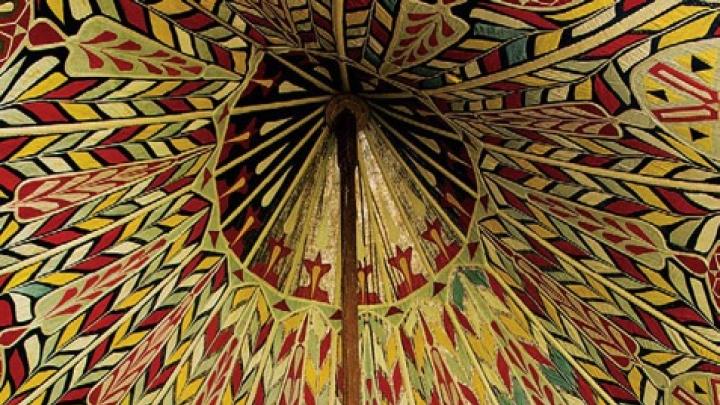Shelters such as this one were typical expedition gear for nineteenth-century Western travelers in Egypt. One may buy or rent similar marquees there today for public functions, much as Harvard hires a host of tents each year to protect celebrants during Commencement week. What distinguishes this richly decorated accommodation is that Francis B. Greene, A.B. 1865, bought it to house him and his bride, Rebecca, on their honeymoon at Giza, encamped close by the Sphinx, the pyramids, and other astonishments, and attended, no doubt, by a retinue of servants. They married October 30, 1879, in Boston. Egyptian honeymoon over, they packed up their tent and brought it home as a souvenir to North Dartmouth, Massachusetts. Francis practiced law in New Bedford. In 1896, the Greenes gave this venue of early wedded bliss to their neighbors, the family of Oliver Prescott, A.B. 1889, LL.B.-A.M. ’92, as a playhouse for the children. In 1987, after nine decades of service in the Prescotts’ backyard, the tent came as a gift of that family to Harvard’s Semitic Museum, which collects objects from the Near East, albeit usually ancient archaeological ones.
Four staffers pitch the tent on the museum’s front lawn on Divinity Avenue each year at Commencement, weather permitting, partly to check the former playhouse’s condition (still fairly robust), and partly to welcome visitors with cookies and fruit juice. It is a circular, bell-topped affair, 13 feet high and 16 feet in diameter, of white cotton canvas, decorated inside with hand-stitched cotton appliqué of geometric and floral designs in Mamluk Revival style in shades of red, green, yellow, blue, and black. Joseph A. Greene (no relation to Francis), the assistant director of the museum, guesses that the enclosure, the size of a large bedroom, could fit 50 people packed tight. A single center pole held in place by about 20 ropes supports the bell. The separate side walls attach with toggles to the edge of the bell. Wooden slats sewn into the walls every three feet or so give them rigidity.
An Arabic inscription in calligraphy runs in a frieze around the top of the walls inside. “It is a fragment of a love poem of the thirteenth century by Baha’ al-Din Zuhayr,” says Greene. “One line reads in part, ‘The enchanting one is a sword in my heart…,’ a sentiment perfectly suited to the original use of the tent.”









